Shade makes your backyard a haven, giving you shelter from the Bergen County heat and humidity, but when you are gardening, it can be a mixed blessing. Creating a beautiful garden when you are blessed with a shady yard can be quite challenging, but it’s not impossible. With the right flowers and shrubs, you can make that shady spot come alive. Shrubs that grow in shade are a diverse lot. Shade loving bushes can provide color and interest to a drab nook in your yard. Ranging from short bushes to tall hedges, these include both evergreen and deciduous plants. Some produce blossoms, while others are planted mostly for their foliage. Read about some of the best shrubs for shade in Bergen County, NJ and try planting them in shady and partially shady areas of your garden.
Here is our list of shrubs best suited for a northern New Jersey shade garden.
Winter Creeper (Euonymus fortunei)
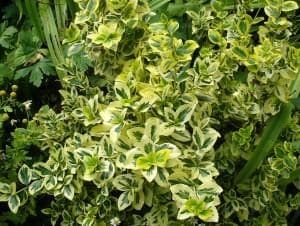 The first on the list is the winter creeper, or Euonymus Fortunei. Known for its versatility, it can be trained into an appealing low growing ground cover. This bittersweet shrub can spread to more than 50 feet, but it only grows about two feet high. The oval shaped leaves are complemented by small flowers and large, orange fruits. This shrub is not picky about its soil, and you can propagate it using tip cuttings.
The first on the list is the winter creeper, or Euonymus Fortunei. Known for its versatility, it can be trained into an appealing low growing ground cover. This bittersweet shrub can spread to more than 50 feet, but it only grows about two feet high. The oval shaped leaves are complemented by small flowers and large, orange fruits. This shrub is not picky about its soil, and you can propagate it using tip cuttings.
Growing tip: Keep the soil moist with consistent watering. Add a layer of bark mulch for moisture retention. Support the stems with a trellis or arbor.
Spiderwort (Tradescantia)
 If you are trying your hand at gardening for the first time and want one of the best shrubs for shade that is also quite easy to grow, you will enjoy the hardiness of spiderwort, or Tradescantia Andersoniana. It is known specifically for its blooming period that can last for weeks. The blade-like leaves can grow 12 or more inches and are the perfect backdrop for flowers that bloom in clear blue, white, pink or purple.
If you are trying your hand at gardening for the first time and want one of the best shrubs for shade that is also quite easy to grow, you will enjoy the hardiness of spiderwort, or Tradescantia Andersoniana. It is known specifically for its blooming period that can last for weeks. The blade-like leaves can grow 12 or more inches and are the perfect backdrop for flowers that bloom in clear blue, white, pink or purple.
Growing up to two feet in height and width, this popular perennial has one-inch flowers that last about two months. The variety of colors allows you to match it to your existing garden. If you wish to breed these, divide a clump and replant.
Growing Tip: For the most plentiful blooms, plant your spiderwort in full sun with moist, well-drained soil.
Surprise Lily (Lycoris squamigera)
 Surprise lily, or Lycoris Sqamigera, will bring beautiful butterflies to your shade garden. The flowers grow on stalks two feet high, and are a lilac or pink color. They measure three inches long and have a strong, pleasant fragrance. This versatile shrub has foot-long gray colored leaves.
Surprise lily, or Lycoris Sqamigera, will bring beautiful butterflies to your shade garden. The flowers grow on stalks two feet high, and are a lilac or pink color. They measure three inches long and have a strong, pleasant fragrance. This versatile shrub has foot-long gray colored leaves.
This plant is not picky about soil. It also tolerates sun, making it one of the best shrubs in shade or partial shade gardens. To propagate the surprise lily, simply divide the plant and replant.
Growing Tip: Plant with ½” of the neck exposed. Use average to fertile garden soil. Make sure the soil is never soggy. Plant outdoors when there is no longer a threat of frost.
Rusty Black-Haw (Viburnum rufidulum)
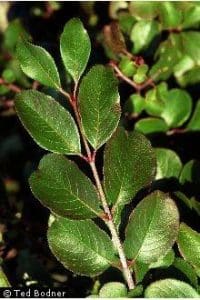 Rusty black-haw, or Viburnum Rufidulum, is one of the best shrubs for shade for homeowners in northern NJ who may find themselves forgetting to water. It is quite drought resistant, so you can plant it and forget it if you need to. The glossy, dark green, deciduous leaves turn a variety of warm hues in autumn.
Rusty black-haw, or Viburnum Rufidulum, is one of the best shrubs for shade for homeowners in northern NJ who may find themselves forgetting to water. It is quite drought resistant, so you can plant it and forget it if you need to. The glossy, dark green, deciduous leaves turn a variety of warm hues in autumn.
The shrub typically grows to about 10 or 18 feet, but in the right conditions it can grow as tall as 25 feet. Small two-to-four-inch leaves and small clusters of white flowers are the defining features of this plant. You can cut green wood cuttings to propagate the rusty Black-Haw.
Growing Tip: The Rusty Black-Haw tolerates the cold and shade well. Grows well in dry soil. It has fruit that attracts birds.
Indian Pink (Spigelia marilandica)
 As you are searching for the best shrubs for shade gardens, don’t forget about the Indian pink, or Spigelia Marilandica. The common name, Indian Pink, refers to its medicinal properties thanks to the alkaloid Spigiline. The dried roots can be used as hallucinogens with possible fatal results if used improperly, so please enjoy only for its horticultural purposes. Growing up to two feet tall with leaves up to six inches in size, this shrub is known for its two-inch-long trumpet shaped flowers.
As you are searching for the best shrubs for shade gardens, don’t forget about the Indian pink, or Spigelia Marilandica. The common name, Indian Pink, refers to its medicinal properties thanks to the alkaloid Spigiline. The dried roots can be used as hallucinogens with possible fatal results if used improperly, so please enjoy only for its horticultural purposes. Growing up to two feet tall with leaves up to six inches in size, this shrub is known for its two-inch-long trumpet shaped flowers.
Growing Tip: Indian Pink needs moist soil. To propagate, divide a clump and replant. When grown in light filtered shade or a few hours of sun, the Indian Pink makes a beautiful perennial. If you remove the old flowers, it will flower again into the summer.
Mountain laurel (Kalmia latifolia)
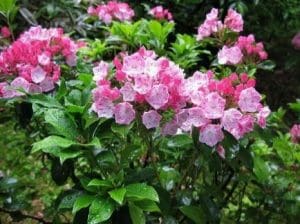 Mountain Laurel native to the north east US. It grows wild all over New Jersey, usually in a shady woods. The foliage is a particularly beautiful glossy green, and in late spring beautiful pink or white, rose or pink flowers form in clusters, transforming a shady spring woods into a beautiful fairy garden. It is an evergreen and that makes it perfect for landscaping year round. Like Azaleas and Rhododendrons, these shrubs like an acidic soil, and yours will do well with this type of fertilizer. This shrub does not do well in clay and should be kept in a moist area. Think woods. Variations of Mountain Laurel have been cultivated specifically for landscaping, and one of the most popular is the dwarf Mountain Laurel which has colorful clusters of flowers.
Mountain Laurel native to the north east US. It grows wild all over New Jersey, usually in a shady woods. The foliage is a particularly beautiful glossy green, and in late spring beautiful pink or white, rose or pink flowers form in clusters, transforming a shady spring woods into a beautiful fairy garden. It is an evergreen and that makes it perfect for landscaping year round. Like Azaleas and Rhododendrons, these shrubs like an acidic soil, and yours will do well with this type of fertilizer. This shrub does not do well in clay and should be kept in a moist area. Think woods. Variations of Mountain Laurel have been cultivated specifically for landscaping, and one of the most popular is the dwarf Mountain Laurel which has colorful clusters of flowers.
Grows best in zones 5-9 and prefers partial shade but will tolerate full sun.
Warning: Don’t let your pets eat this shrub because if ingested it can cause gastrointestinal issues, coma, or death.
Japanese Rose (Kerria japonica)
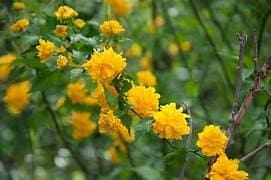 The genus name, Kerria comes from William Kerr, who brought the plant from the Far East to the West. The Japanese Roses color accounts for the common name, Yellow Rose of Texas.
The genus name, Kerria comes from William Kerr, who brought the plant from the Far East to the West. The Japanese Roses color accounts for the common name, Yellow Rose of Texas.
The Japanese Rose does very well in a shaded New Jersey landscape. With an interesting yellow-green bark, this shrub is deciduous, losing its leaves in the fall, and first flowers in the spring, although flowers may bloom many times during the season. It can easily spread, but you can control this by cutting suckers back. Perfect for northern New Jersey it grows well in zones 4 to 9, loamy soil and partial shade.
Climbing Hydrangea (Hydrangea anomala ssp. petiolaris)
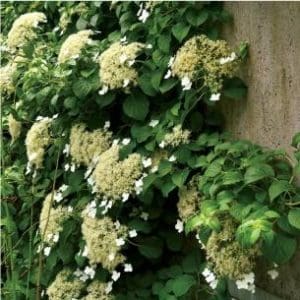 Native to Japan, Korea and Siberia, this plant is more of a vine, but can be trimmed and maintained as if they were shrubs. They work well in zones 4 to 7, making them perfect for Northern New Jersey, and while they do better when exposed to partial sun, will also tolerate shade. Another deciduous plant, even though they lose leaves in the fall, the peeling bark on their stems makes them an interesting focal point in a winter landscape.
Native to Japan, Korea and Siberia, this plant is more of a vine, but can be trimmed and maintained as if they were shrubs. They work well in zones 4 to 7, making them perfect for Northern New Jersey, and while they do better when exposed to partial sun, will also tolerate shade. Another deciduous plant, even though they lose leaves in the fall, the peeling bark on their stems makes them an interesting focal point in a winter landscape.
Keep the soil around them evenly moist with consistent watering’s and a layer of bark mulch. It is best to plant against stone, brick, masonry wall or rot-resistant wood. When it is first planted Climbing Hydrangea do not quickly thrive. It takes a few years, but once it has created a good root base, it will begin to climb and spread quickly and be covered all summer with foamy white or pale blue flower clusters. This vine is low-maintenance in moist acidic soil and partial shade.
Carol Mackie Daphne (Daphne)
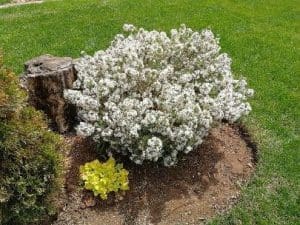 While Daphne shrubs are widely used in Southern gardens, they also do well in New Jersey, growing in zones 4 to 8. Best known for their variegated grayish green leaves and fragrant flowers, they are wonderful accents in any partially shaded garden. Unlike many of the shrubs we have previously discussed these plants do not like acidic soil, so you may have to add some lime for best results. The soil should also be moist and well-drained. Flowers can be white or light pink.
While Daphne shrubs are widely used in Southern gardens, they also do well in New Jersey, growing in zones 4 to 8. Best known for their variegated grayish green leaves and fragrant flowers, they are wonderful accents in any partially shaded garden. Unlike many of the shrubs we have previously discussed these plants do not like acidic soil, so you may have to add some lime for best results. The soil should also be moist and well-drained. Flowers can be white or light pink.
Warning : The leaves and berries are toxic if eaten, and can cause skin irritation.
Emerald and Gold Euonymus (Euonymus fortunei)
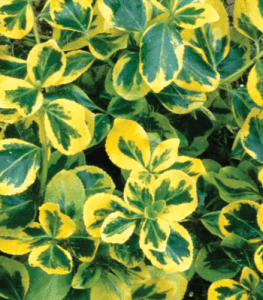 This shrub is native to Asia but also grows well in Northern New Jersey doing best in zones 5-8. Named for its yellow and gold leaves, you may also know it by the nickname of “wintercreeper”. When grown in full sunlight it gets its leaves tinge pink in the winter. The leaves also turn more gold during summer months when the plant is allowed full sun. These shrubs grow quickly in a moist and well-drained area, in partial sun to full shade. This low evergreen shrub spreads quickly and is used as a ground cover, low edges, and as erosion control on slopes. For this reason it earned the respected Award of Garden Merit by the Royal Horticultural Society.
This shrub is native to Asia but also grows well in Northern New Jersey doing best in zones 5-8. Named for its yellow and gold leaves, you may also know it by the nickname of “wintercreeper”. When grown in full sunlight it gets its leaves tinge pink in the winter. The leaves also turn more gold during summer months when the plant is allowed full sun. These shrubs grow quickly in a moist and well-drained area, in partial sun to full shade. This low evergreen shrub spreads quickly and is used as a ground cover, low edges, and as erosion control on slopes. For this reason it earned the respected Award of Garden Merit by the Royal Horticultural Society.
Hetz Japanese Holly (Ilex crenata Hetzii)
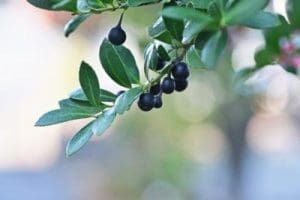 There are two popular Japanese Hollies that tolerate shade, and Hertz is the one with smaller leaves and black berries. It is very similar to a boxwood shrub and can be trimmed to form shaped hedges. In fact, this plant does better when regularly pruned. It grows well in zones 5-8 making it a good choice for any Northern New Jersey shade garden. It even tolerates clay but prefers well-drained soil.
There are two popular Japanese Hollies that tolerate shade, and Hertz is the one with smaller leaves and black berries. It is very similar to a boxwood shrub and can be trimmed to form shaped hedges. In fact, this plant does better when regularly pruned. It grows well in zones 5-8 making it a good choice for any Northern New Jersey shade garden. It even tolerates clay but prefers well-drained soil.
Sky Pencil Holly (Ilex crenata)
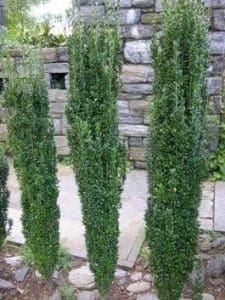 The other Japanese Holly that tolerates shade is the Sky Pencil Holly which is easy to identify by its tall, cylindrical shape. Leaves are greenish to white and small with smooth edges. You can plant this shrub in corners, as borders, or in tight spaces. Its berries are also black and attract birds. Unlike the Hertz you do not have to prune this holly, but if you want to prune, do it in winter. This shrub can grow up to 10 feet tall, and stays green all winter, making it a good choice for a privacy hedge. It grows very well in Northern New Jersey in zones 6-8 and likes well-drained acidic soil.
The other Japanese Holly that tolerates shade is the Sky Pencil Holly which is easy to identify by its tall, cylindrical shape. Leaves are greenish to white and small with smooth edges. You can plant this shrub in corners, as borders, or in tight spaces. Its berries are also black and attract birds. Unlike the Hertz you do not have to prune this holly, but if you want to prune, do it in winter. This shrub can grow up to 10 feet tall, and stays green all winter, making it a good choice for a privacy hedge. It grows very well in Northern New Jersey in zones 6-8 and likes well-drained acidic soil.
Canadian Hemlock (Tsuga canadensis)
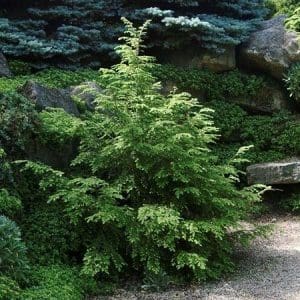 There are several varieties of Canadian Hemlock, including Tsuga Canadensis, Eastern Hemlock or Eastern Hemlock-Spruce and they are hearty in zones 3-7, which includes Northern New Jersey. This coniferous tree is actually native to Eastern North America, and attracts birds and wildlife for this reason. Its needles can be pruned to make a perfect, dense privacy screen or hedge, and are also ideal as foundation plants because they can grow to 70 feet tall in increments of 12-24 feet a year. In New Jersey Hemlocks do well with a layer of mulch, and grow best in moist, acid soil. A fun fact about the Canadian Hemlock is that native Americans used the bark to cure leather, preserve food and brew a tea rich in vitamin C.
There are several varieties of Canadian Hemlock, including Tsuga Canadensis, Eastern Hemlock or Eastern Hemlock-Spruce and they are hearty in zones 3-7, which includes Northern New Jersey. This coniferous tree is actually native to Eastern North America, and attracts birds and wildlife for this reason. Its needles can be pruned to make a perfect, dense privacy screen or hedge, and are also ideal as foundation plants because they can grow to 70 feet tall in increments of 12-24 feet a year. In New Jersey Hemlocks do well with a layer of mulch, and grow best in moist, acid soil. A fun fact about the Canadian Hemlock is that native Americans used the bark to cure leather, preserve food and brew a tea rich in vitamin C.
1. Yews (Taxus genus)
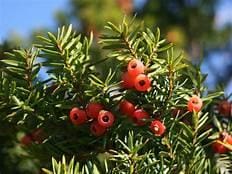 Yews come in 13 species with 72 trinomials and more than 400 registered cultivars, so there are many choices. Taxus means “the red tree” likely due to their vibrant red berry-like cones. They grow well in shade, and make wonderful garden groupings, hedges and focal points because they can be trimmed into attractive shapes. They grow in zones 4-7 and prefer well-drained soil. Yews are poisonous if ingested, except for the tempting red berries which appeal to birds and, unfortunately to deer.
Yews come in 13 species with 72 trinomials and more than 400 registered cultivars, so there are many choices. Taxus means “the red tree” likely due to their vibrant red berry-like cones. They grow well in shade, and make wonderful garden groupings, hedges and focal points because they can be trimmed into attractive shapes. They grow in zones 4-7 and prefer well-drained soil. Yews are poisonous if ingested, except for the tempting red berries which appeal to birds and, unfortunately to deer.
2. Andromeda (Pieris japonica)
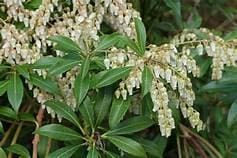 The Andromeda shrub has many nicknames including, Japanese Andromeda, Japanese Pieris or the Dwarf Lilly-of-the-Valley. A member of the Heather family, Ericaceae, it is native to the mountains of Eastern China, Taiwan and Japan, but also thrives in Northern New Jersey, growing well in zones 5-7. There are many cultivated hybrid varieties, including Pieris, the Forest Flame, named for its beautiful red-tinged variegated foliage. It is an evergreen and offers interest in every season, from its highly fragrant flowers in spring, to its beautiful evergreen leaves.
The Andromeda shrub has many nicknames including, Japanese Andromeda, Japanese Pieris or the Dwarf Lilly-of-the-Valley. A member of the Heather family, Ericaceae, it is native to the mountains of Eastern China, Taiwan and Japan, but also thrives in Northern New Jersey, growing well in zones 5-7. There are many cultivated hybrid varieties, including Pieris, the Forest Flame, named for its beautiful red-tinged variegated foliage. It is an evergreen and offers interest in every season, from its highly fragrant flowers in spring, to its beautiful evergreen leaves.
Andromeda tolerates shade, but also grows well in full sun, preferring slightly acidic, well-drained soil, similar to Rhododendrons and Azaleas.
Conclusions
While all plants require some light to thrive, each of these are going to grow well in a mostly shady area. As you plan your garden, don’t overlook the shady parts. With some of the best shrubs in Bergen County shade gardens, you will be able to create a beautiful space that will thrive without direct sun exposure.
Wikipedia for historical facts- Andromeda (Pieris japonica) Yews (Taxus genus) Canadian Hemlock (Tsuga canadensis) Sky Pencil Holly (Ilex crenata) Emerald and Gold Euonymus Carol Mackie Daphne (Daphne)
